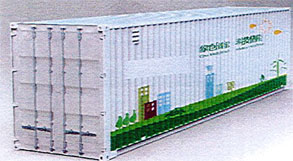
The village Board of Trustees will hold a special meeting Oct. 2 to decide whether or not to approve a permit that would allow for the installation of a large lithium battery on vacant land at 982 Hudson Ave.
The battery, the size of a tractor trailer container, would serve as power backup to a NYSEG electric transformer that gets overloaded during peak demand periods and is in need of a $10.5 million upgrade. The meeting will be held at 6 p.m. at Village Hall.
The Village Board held a nearly two-hour public hearing on the proposal Sept. 18 in which a handful of neighbors had questions about the aesthetics of the plan, and potential noise and safety hazards the battery may pose.
Presenting at the hearing were representatives from NYS Electric & Gas (NYSEG), which owns and operates the transformer located in the Town of Stillwater near Castle Heights, and E-ON, a global electric utility group operating in 30 countries serving Europe and the United States.
Instead of spending the millions to upgrade the transformer, NYSEG has been looking for lower cost alternatives, seeking ideas from futuristic companies specializing in new energy technologies. E-ON, which stands for Energy On, specializes in “storage energy” and was chosen by NYSEG from 12 proposals from other companies worldwide.
They also looked at windmill and solar power as a “non-wires alternative” to replacing the transform, but the battery was the most economical solution, NYSEG said. The battery would operate at about 20 percent of the transformer replacement cost and last up to 20 years. E-ON would supply the battery and technology to NYSEG under a lease contract.
The company and utility are seeking a special use permit from the village to install the battery on private land on Hudson Avenue that E-ON would lease from the property owner.
The company is also seeking a variance from the village Zoning Board of Appeals to install an eight-foot chain link fence on the property to surround and protect the battery, and is seeking further approvals from the Saratoga County Planning Board.
The battery plan was first proposed to the village back in April, but at that time the site of choice was the former village water treatment plant on Ferry Lane near the Hudson River. But after further study, that land did not meet their needs so they focused attention on the private parcel on Hudson Avenue.
During the presentation, several E-ON representatives went through a slideshow explaining:
- Who E-ON is
- What the project was about
- How the technology works
- Why they chose the Hudson Avenue location
- The specific site plan submitted to village
- The project’s construction details and timeline
- Fire safety measures in place and battery maintenance requirements
The representatives explained that the battery stores energy at night time when it’s cheapest and plentiful. Then, in the middle of the day when energy is in most demand on the transformer, the battery would turn on and lower the overall load in the area. The Hudson Avenue location is in the middle of the electric energy circuit so it is in a spot where it would be most effective.
The battery would be sealed and locked in an 8 X 8 X 40-foot container and take up about 5,000 square feet of the property. The container would be painted green to blend in with the foliage and additional landscaping would be added to further block the container from view and mitigate any noise to neighbors. A locked, chain link fence would surround the unit as well.
The proposal meets all village set back requirements and state environmental regulations, E-ON representatives said. The battery would be monitored 24/7, 365 days a year by E-ON for potential problems and maintained twice a year in spring and fall.
NYSEG and E-ON would like to have the battery up and running by the end of the year with an anticipated three to four-month construction timeline. The “earth work” would be done first, burying electrical wiring and cabling, grading an entrance road and pouring a concrete pad where the unit would sit. Then there would be a 30-day waiting period for the concrete to cure before the battery is hooked up and tested.
Representatives said there would be “minimal” construction noise and crews would only work weekdays during daytime hours.
